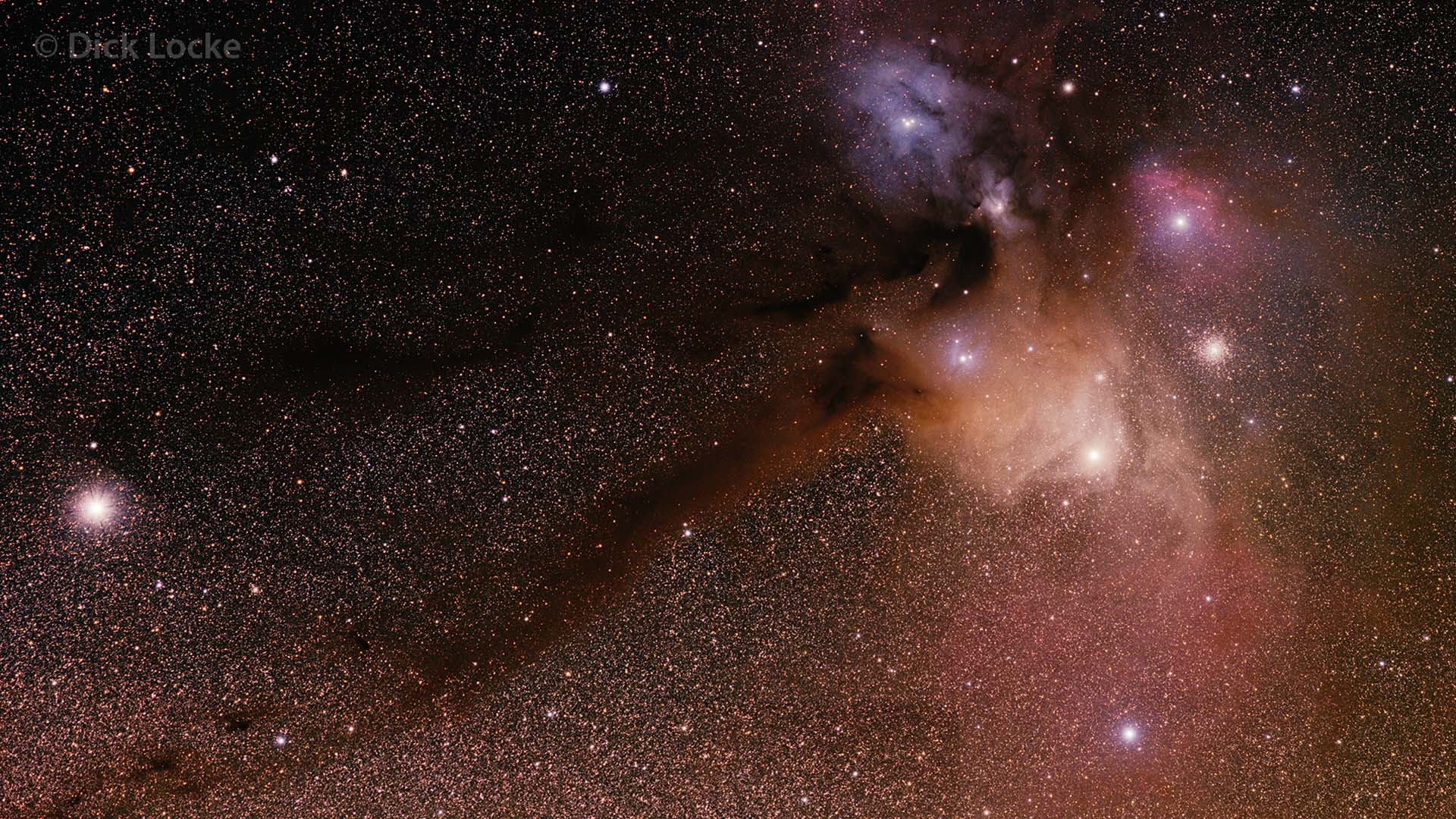
Antares Area - 2016 Davis Mountains
This page features wide-angle shots of Scorpius and the Antares area. Scroll down for a visual index of pages dedicated to many objects displayed here. Prime focus (close-up) shots are here.

The incomparable Antares area in Scorpius was available during my Spring 2016 trip to the Davis Mountains. I spent a fair amount of imaging time on the area - it's awesome, the most interesting area of the sky, so how could I not? This page has a discussion of how the various colors come about. This page has a "close-up" crop of the image, showing off the resolving power of the Zeiss 135mm lens.
Antares is the bright star bottom right of the orange/yellow area. Antares is a fascinating star, read about it on my Antares prime focus page. There's a small globular cluster NGC 6144 above that. M4 is the large star cluster directly to the right of that. There's a red nebula surrounding the star Sigma Sco. The small blue nebula above and left of Antares is IC 4605. IC 4603 is above that, and IC 4604 is the larger blue reflection nebula; Rho Ophiuchi is one of the bright stars providing the light source. See my Antares Prime focus page for close-ups of some of the objects embedded in this image. If something seems out of place here, that would be Saturn on the lower left of the image! The image above covers a section of a larger mosaic that requires more work, watch this space.
Nikon D810A camera, Zeiss 135mm lens at f4 riding piggyback and guided on the AP 900GTO mount. This is a mosaic composed of 65 frames of 5 minutes exposure each. My image processing techniques are discussed here.

Click above for a big image of colorful stuff. It's resized down a bit, unlike what's on the Zeiss page.
During my March 2009 Astronomy trip I was intent on getting some new images of the colorful area around Antares and Rho Ophiuchi. Images on this page used my "advanced blending techniques."

Working Version #2, May 17th. Updated previous image to include blended telescope shots. Click on the picture to see the full sized "HD" 1920x1200 pixel image. Antares is the yellow star to the middle right; it lies in the heart of the constellation Scorpius the scorpion. The above image (28 frames * 5 min. each = 140 minutes total exposure) used an Olympus Zuiko 135mm f2.8 camera lens mounted to my Canon EOS D20a; PLUS a number of prime focus pictures using the Takahashi TOA 130 Telescope (a 5" APO refractor telescope) with the reducer, AP 900GTO mount, and QHY8 CCD Camera blended in... My current image processing workflow is here. Other March 2009 Astronomy Images are at this link. Exposure details on the prime focus images are on this page Scorpius/Antares.
More information on this colorful area of the sky is available at this APOD (Astronomy Picture Of the Day) link. But wait, there's a new APOD from April 2010
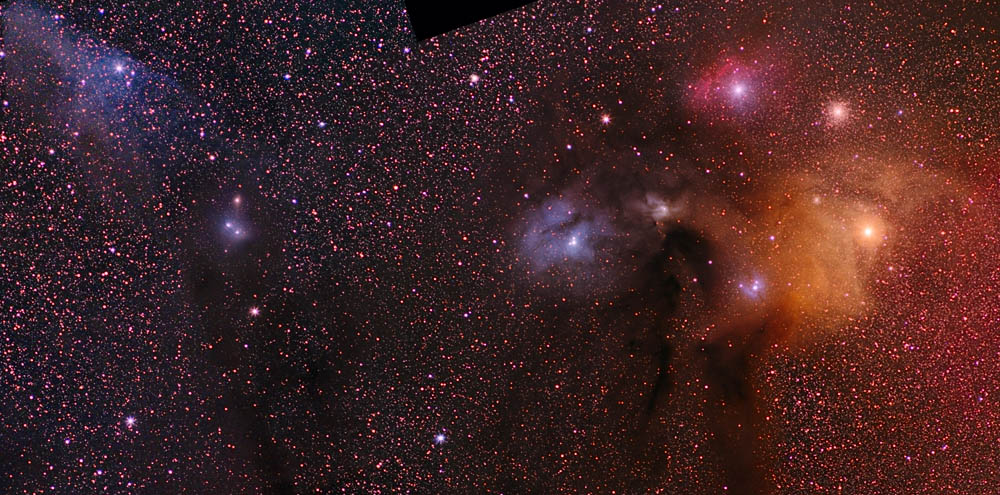
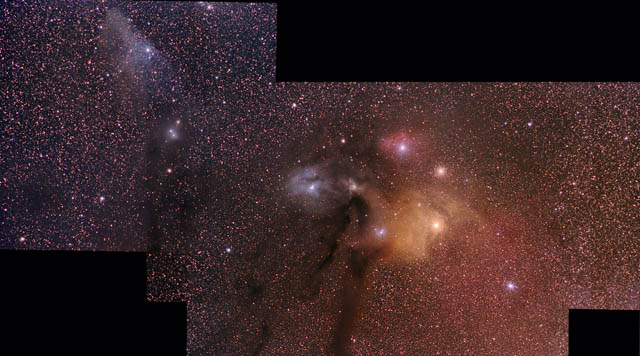
The views above and below give hints as to how everything goes together.
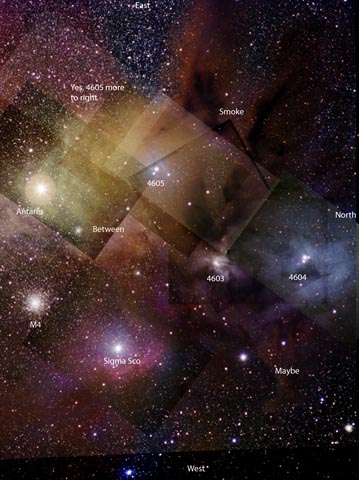
Here's a Guide I made to planning & framing the prime focus shots; sorry it's reversed from my image! Off to the right of this image, out of site, you would find IC 4601 and IC 4592. More info on this area at is these two APOD's, one here and another here.

Lots going on in this 22 minute exposure at f2.8. Antares is the yellow star to the middle right; it lies in the heart of the constellation Scorpius the scorpion. To the left, buried in the nebulosity, is a small globular cluster NGC 6144, and above M4, a larger globular cluster. Toward the left edge of the screen the red emission nebula fades into the blue reflection nebula, and then into a large dark nebula (B44 I think). Nikon F2 camera, Nikon 300mm f2.8 ED lens @ f2.8, 22 minutes exposure, Kodak LE 400 film, and the usual astro processing in Photoshop.

Antares view with a DSLR. 255 seconds at ISO 200, Nikon D100 D-SLR, same lens as above. I used the in-camera noise reduction function.
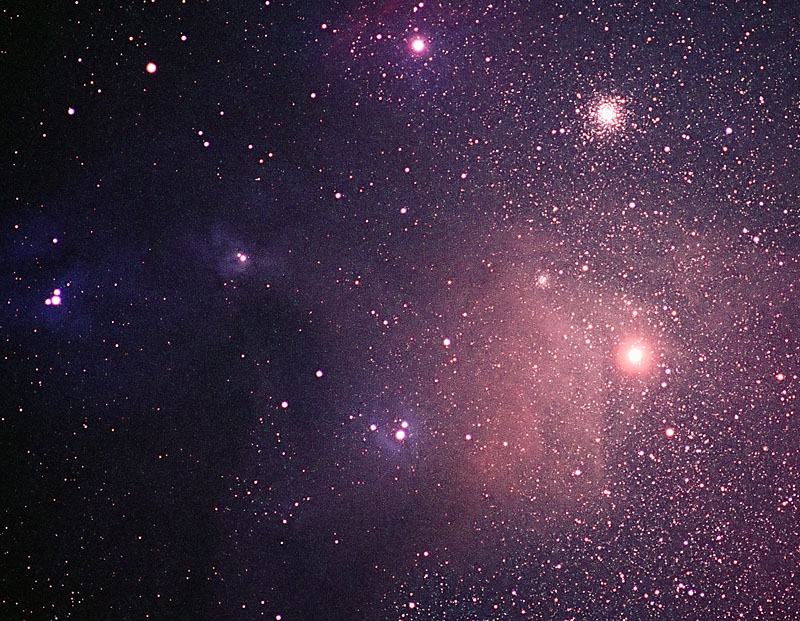
Combined version of two DSLR Antares images. Note that while missing some of the red emission nebula due to weak red response in the DSLR, the blue reflection nebulae are picked up nicely. Above Antares you can see the large M4 star cluster, dark nebula VdB 104 near Sigma SCO. Following Antares yellow dust cloud to the left you find 3 reflection nebulae: IC 4605, 4603, 4605. See below for close-ups of IC 4603 and 4604. Nikon 300mm f2.8 ED lens, Davis Mountains, TX, May 2004, STV auto guider, Losmandy GM-11,
Negative Scan, Nikon Coolscan IV ED, Processed in Photoshop
Copyright © 2004-2016 Dick Locke. All Rights Reserved. Updated 7/12/12, 10/12/13, 3/11/14, 6/17/16.
Contact and Image Use Information